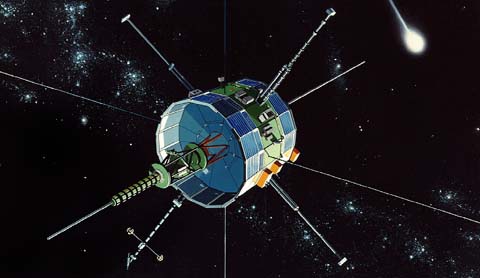Although its scientific work for NASA ended in the early 1980s, the International Sun-Earth Explorer never quite died — and this week it was revived by a team of volunteers intent on letting it continue exploring interplanetary space.
This isn't the kind of posting you'll find on monster.com:
JOB WANTED: Veteran interplanetary spacecraft seeks new assignment after two successful comet flybys. Electronic systems old but fully functional. Skills include two working radio systems, ample fuel reserves, and one dozen scientific instruments in good working order. Willing to relocate. Please confirm intent by mid-June 2014.

But it neatly sums up the amazing story of NASA's International Sun-Earth Explorer 3. Launched in 1978, the craft has been silently cruising around the Sun ever since space-agency engineers shut it down in 1999. However, that's not the end of the story. Realizing that ISEE 3 would pass close to Earth in August 2014, a group of about 20 space buffs banded together to mount an improbable effort to reestablish communication with the craft.
Thorny problems arose almost immediately. NASA long ago abandoned the technology to communicate with ISEE 3. It no longer had radio dishes rigged to transmit and receive at the right frequency nor the programs needed to command the craft. Also, NASA managers weren't really interested in spending time or money to reestablish contact. Ground controllers last contacted the craft in 1999, ostensibly for the final time, but they neglected to turn off its carrier signal.
None of this dissuaded the craft's would-be resuscitators, a team of engineers, programmers, and scientists led by veteran spacewatchers Dennis Wingo and Keith Cowing and collectively known as the ISEE-3 Reboot Project. Yesterday the group proudly tweeted, "SUCCESS! We are now in command of the ISEE-3 spacecraft!"
The two-way communication culminated many months of unearthing the old code, scavenging equipment, and finding a suitable radio dish (two, actually, at Morehead State University in Kentucky and in Bochum, Germany). Money was needed too, and a crowdfunding effort yielded more than 2,200 donors and nearly $160,000.
First contact came thanks to the Arecibo giant radio dish in Puerto Rico, at which the team installed a makeshift receiver and transmitter inside the alien-looking receiver dome. All that remained was approval from NASA to attempt contact, and that go-ahead came on May 29th. The team successfully established contact that afternoon — notwithstanding a minor earthquake in the area — at a heart-thumping transmission rate of 512 bits per second.
Time Was Running Out
Why all this fuss over a 35-year-old spacecraft? The 355-day-long orbit of ISEE 3 around the Sun isn't much different from Earth's, and the spacecraft will be passing close by in August. Do nothing, and it would simply sail by.
But with the craft back under human control, its rocket can be fired beginning in mid-June to direct it into a holding pattern near the Lagrange point, roughly 1 million miles from Earth's sunward side. This 2½-minute video shows how the capture would take place:
Once safely in near-Earth storage, ISEE 3 could easily be redirected to encounter a third comet. Although it carries no cameras, this spinning drum-shaped spacecraft has a robust set of instruments for studying charged particles, electromagnetic fields, and related phenomena.
Initially, ISEE 3 was sent to that same L1 location to study the solar wind and its interactions with Earth. Its work their finished, the craft was rechristened the International Cometary Explorer and dispatched to fly through the gas-and-ion tail of Comet Giacobini-Zinner in September 1985 and that of Comet Halley six months later.
Actually, it wasn't quite that simple. Coaxing the craft to head off toward Comet G-Z required a complicated sequence of rocket firings, combined with multiple close flybys with the Moon and Earth. This convoluted celestial choreography was the work of Robert W. Farquhar, who's long since retired — but understandably eager awaiting the spacecraft's return to near-Earth space.
 2
2
Comments
Anthony Barreiro
May 30, 2014 at 5:14 pm
What a fascinating story! Freebooting satellite wranglers. Somebody should make a movie.
You must be logged in to post a comment.
May 30, 2014 at 11:44 pm
As Anthony above said, somebody should make a movie out of this, at least one made for TV. This is great stuff to see and it would be very interesting to learn how it all happened and what the team had to go through to activate the old spacecraft. Amazing story, great work.
You must be logged in to post a comment.
You must be logged in to post a comment.